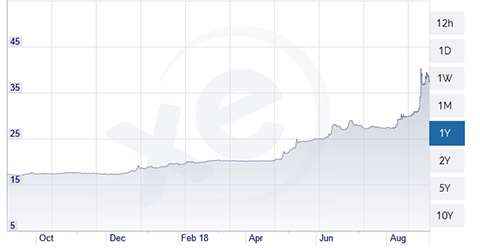Argentina is in trouble. It is dominating world headlines once again.
The Argentinean peso has recently been losing ground against the US dollar.
As you can see in the graph below, the peso has devalued from US$17 in October last year, to about US$38 at time of writing.
That´s a devaluation of 120% in only a year!
 |
Source: XE |
The Argentinean peso started diving in April. To stop the freefall, the central bank raised interest rates from 27% to 40% in the span of a couple of weeks.
US Dollar Has Been Strengthening
The problem is that the US dollar has been strengthening. Argentina has been taking high amounts of debt in a short time in foreign currency. With the US dollar strengthening, Argentina is having trouble refinancing the debt. They are also spending large amounts of their foreign reserves to keep the peso afloat.
Back in June, when the currency first started plummeting, Argentina negotiated a US$50 billion credit line for 36 months with the International Monetary Fund (IMF). In fact, this is the largest loan the IMF has given out…ever. Even more than Greece…
Argentina is looking at the loan as a way to rebalance their accounts until the end of 2019.
Yet the loan has done nothing to calm investor fears. In fact, things have gotten worse.
In the last few weeks, the peso has devalued even more, as you can see in the graph above. To stop the haemorrhage, the Argentinean Central Bank has now increased interest rates to a whopping 60%, all in an attempt to stop investors from running to the US dollar.
Can you imagine that happening in Australia? I mean, the Reserve Bank of Australia has been keeping rates on hold at a low 1.50% for the last two years.
[openx slug=inpost]
Argentina now has the highest interest rates in the world.
Argentina isn´t the only country concerning investors.
A few other emerging markets are also struggling.
Turkey, South Africa, Brazil…
These countries have been increasing debt in foreign currency and their currencies have been declining quickly. They have also been using their foreign reserves to prop their currencies.
There are concerns about how much the US dollar can go up. And, of course, money is flowing out from emerging markets as the US dollar becomes more lucrative as interest rates in the US rise.
There are worries now that a crisis could hit emerging markets, triggering a global crisis.
Latest Developments Are Extremely Worrying
For Argentineans, the latest developments are extremely worrying.
For one, they were surprised at the large amount of the loan. Why does Argentina need such a large loan? Plus, there aren´t many details on the deal either.
The other thing is that Argentina has quite a close connection with the US dollar. They use it to give out credits, to price certain assets and as a reference. It is one of the barometers they use to measure if the country and the economy are going well…
The problem is, there seems to be no end to the peso depreciation.
Argentina´s economic minister, Nicolas Dujovne, has said their objective is a ‘zero deficit’ by 2019.
The problem is that Argentina´s GDP is US$545 billion annually. The US$50 billion loan is about 9% of Argentina´s GDP. You need to create quite a bit of growth to be able to pay that amount of debt quickly. And then there are also interest payments to consider…
The IMF has been quick to come to Argentina´s rescue.
If you are not familiar with the fund, it was created after the Second World War. It´s main function is to lend money to countries with large deficits so as to maintain global financial stability.
The IMF relies on giving out credit to fund its own expenditures.
Argentina joined the fund in 1956. Argentina and the IMF have had a long tumultuous relationship. In those 62 years, Argentina has received money from the fund numerous times, with questionable results.
Argentina has become dependent on the IMF over its history to get loans to survive. Yet, in the last few years, in my opinion, the fund has lost certain relevance in the world arena.
Argentina may not be able to live without the fund. But the fund also needs Argentina. Rescuing Argentina gives the fund visibility, and worldwide headlines.
Best,
Selva Freigedo





